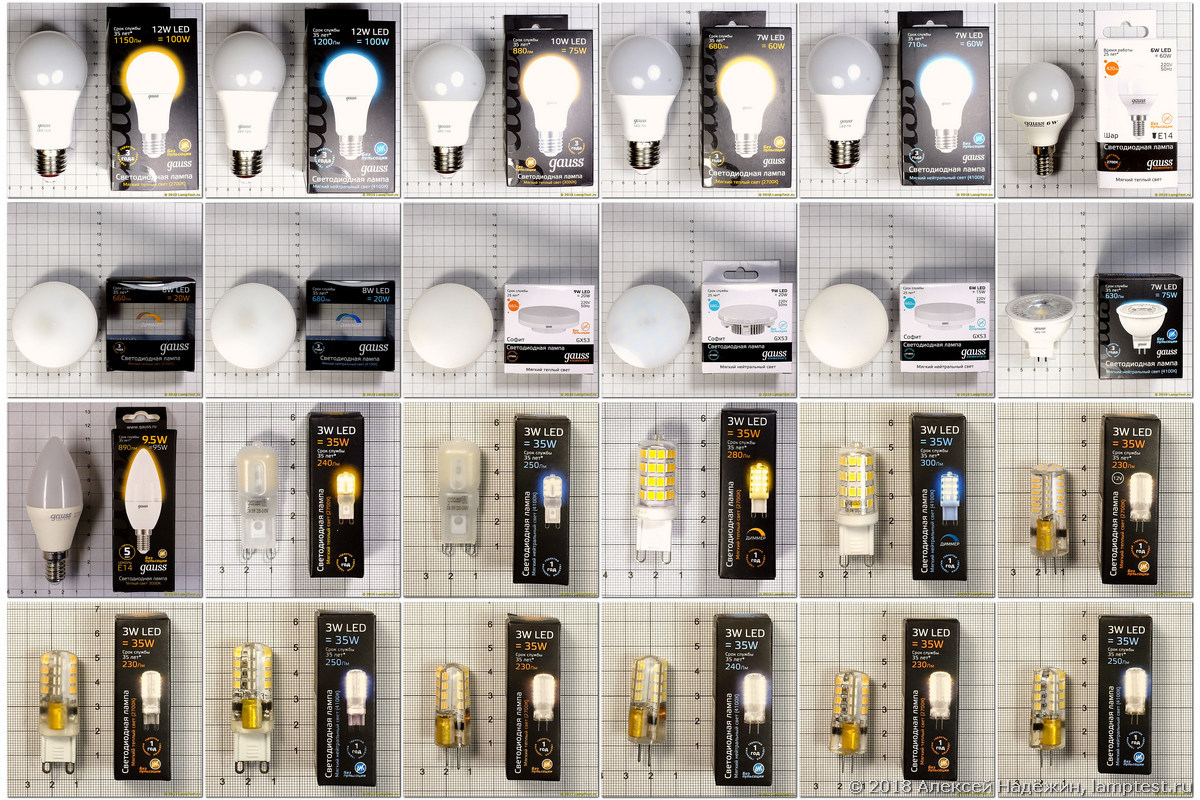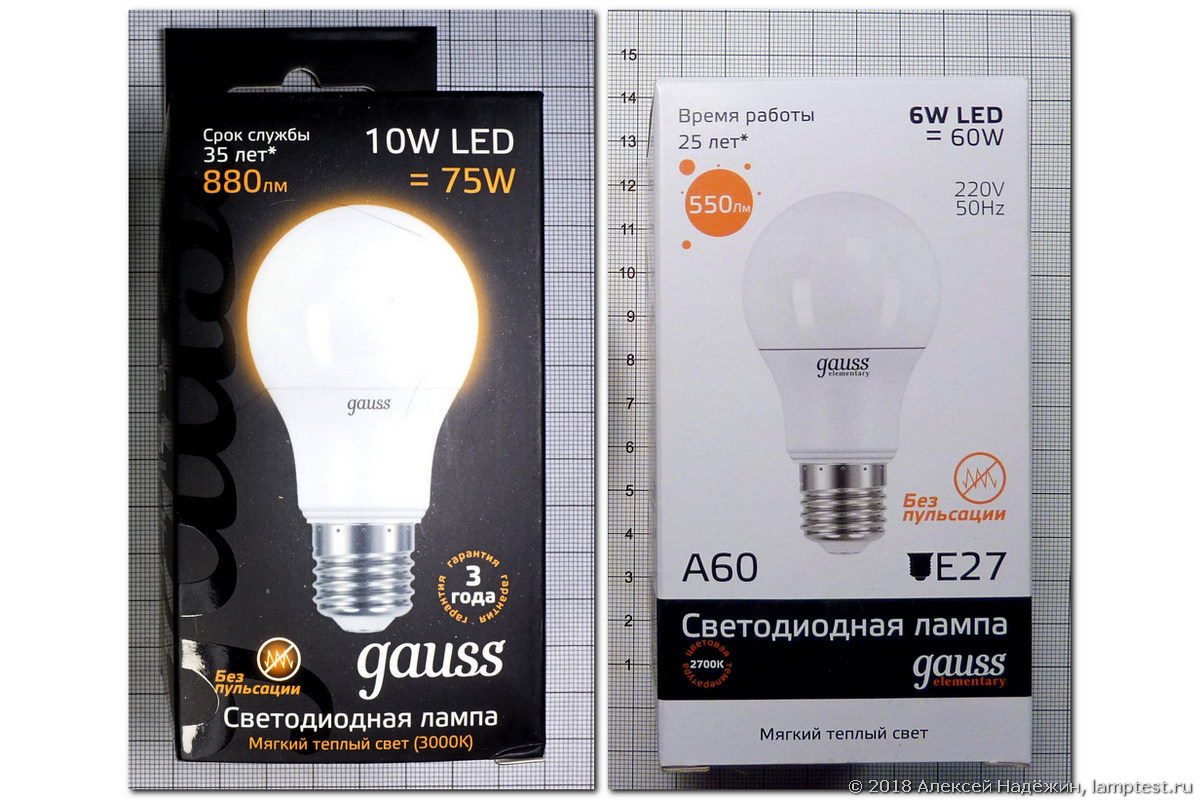LED lamps Gauss 2017-2018 year
LED lamps of the Russian brand Gauss appeared on the market among the first. Many consider the lamps of this brand among the best and there are really few complaints about it.
Unfortunately, Gauss, releasing quality lamps, always brought on the package overestimated characteristics and indicated unrealistic values of the color rendering index (CRI, Ra).
Today I will analyze the results of my testing of twenty-four Gauss lamps, released in 2017 and 2018.
')

Two series of lamps are produced - Gauss in black packaging and Gauss elementary in white packaging (cheaper version).

On lamps in black packaging Ra> 90 is indicated, on lamps in white packaging Ra> 80, but unfortunately this is not true. In reality, CRI (Ra) lamps in black packaging are 81-84, in white packages - 73-76.
The warranty period for most lamps in black packaging is 3 or 5 years, for elementary lamps in white packaging and for capsule lamps (G4 and G9) in black packaging - 1 year.
On the packaging of most lamps it is written “without pulsation” and this is true, but there are lamps on which this is not written, and there was found an unacceptable one hundred percent ripple. Such lamps are definitely not worth buying.
Luminous flux, color temperature and color rendition index were measured using a two-meter integrating sphere and a Instrument Systems CAS 140 CT spectrometer , lighting angle and consumption characteristics with a Viso Light Spion instrument, power consumption with a Robiton PM-2 instrument, pulsation with an Uprtek MK350D instrument . The minimum operating voltage, at which the luminous flux decreased by no more than 10% of the nominal, was measured using a Lamptest-1 device, Stable Stab Instab 500 , LATP Suntek TDGC2-0.5 and an Aneng AN8001 multimeter . Before measurements to stabilize the parameters of the lamp heated for half an hour.

As can be seen from the table, all lamps have actual power less than stated. Black series pear lamps give 81-85% of the promised luminous flux, however, in terms of the equivalent of an incandescent lamp, they correspond to the declared ones.
For some reason, Gauss has always indicated a color temperature of 2700K for its “warm” lamps, although in fact it is always higher and is about 3100K, the color temperature of lamps with a neutral light is about 4000K, and 4100K is written on the package.
The only tested lamp, released in 2018 and guaranteed for five years, is a candle with a declared power of 9.5 W, a luminous flux of 890 lm and the equivalent of a 95 W incandescent lamp actually consumes 8 W, gives 703 lm and replaces an incandescent lamp of 70 W, which for E14 candles are still a lot. Interestingly, this lamp has a color temperature of 3000K and in fact it is. I hope that in 2018 the color temperature on all the lamps began to indicate correctly.
The actual color indices of all these lamps (CRI, Ra) are 80-82, even though the packages indicate “above 90”. These are normal values for household lighting lamps, but nothing outstanding, as in lamps with a CRI above 90, they do not.
Lamps in white boxes from the Elementary series have color rendering indices 73-76 (and “above 80” is written on the package), but their luminous flux almost corresponds to the declared one.
All “pears”, “ball” and “candle” work correctly with switches that have an indicator (they do not flash and do not light up when the switch is turned off). Three GX3 spots also work correctly, and two from the white series are faint when the switch is turned off.
Most lamps contain a built-in stabilizer and their brightness does not change when the supply voltage varies widely. All lamps, except for dimmable ones, operate at a decrease in the mains voltage of up to 135 volts, and some also operate at lower voltages.
The two dimmable GX53 spots have a ripple factor of about 30%. Such a pulsation is almost not noticeable visually, but still it is. I note that on the packaging of these lamps there is no “no ripple” sign.
The luminous flux of all tested spots almost corresponds to the stated.
Gauss capsule microlamps split into two “camps”. Those with a “no ripple” sign do have a pulsation coefficient of less than 1%, and those with no no sign, alas, have a pulsation rate of 100% and it’s better not to buy such lamps.
The luminous flux of all microlamps is substantially less than declared (by 18-38%) and only for 12-volt G4 microlamps it almost corresponds to the declared one. The color temperature of “warm” lamps, as well as of other types of lamps, is closer to 3000K than to the declared 2700K.
All good capsule lamps (those with a pulsation of 100%, and you shouldn't talk) cannot work correctly with switches that have an indicator (they flash when the switch is off).
Based on the test results, the following conclusions can be drawn:
• Gauss black series are good lamps, but you need to keep in mind that their actual power and luminous flux are lower than stated, and the actual color rendering index is slightly more than 80;
• Gauss white Elementary series have a color rendering index slightly above 70, therefore it is better not to use them for lighting residential premises;
• It is very important to pay attention to the “No Pulsation” sign on the package of Gauss lamps. If it does not exist, the pulsation is most likely to occur, and in the case of capsule microlamps up to 100%.
PS Data for all Gauss lamps tested on Lamptest .
PPS I will try in the near future to test a large number of lamps Gauss 2018 release.
© 2018, Alexey Nadyozhin
Unfortunately, Gauss, releasing quality lamps, always brought on the package overestimated characteristics and indicated unrealistic values of the color rendering index (CRI, Ra).
Today I will analyze the results of my testing of twenty-four Gauss lamps, released in 2017 and 2018.
')

Two series of lamps are produced - Gauss in black packaging and Gauss elementary in white packaging (cheaper version).

On lamps in black packaging Ra> 90 is indicated, on lamps in white packaging Ra> 80, but unfortunately this is not true. In reality, CRI (Ra) lamps in black packaging are 81-84, in white packages - 73-76.
The warranty period for most lamps in black packaging is 3 or 5 years, for elementary lamps in white packaging and for capsule lamps (G4 and G9) in black packaging - 1 year.
On the packaging of most lamps it is written “without pulsation” and this is true, but there are lamps on which this is not written, and there was found an unacceptable one hundred percent ripple. Such lamps are definitely not worth buying.
Luminous flux, color temperature and color rendition index were measured using a two-meter integrating sphere and a Instrument Systems CAS 140 CT spectrometer , lighting angle and consumption characteristics with a Viso Light Spion instrument, power consumption with a Robiton PM-2 instrument, pulsation with an Uprtek MK350D instrument . The minimum operating voltage, at which the luminous flux decreased by no more than 10% of the nominal, was measured using a Lamptest-1 device, Stable Stab Instab 500 , LATP Suntek TDGC2-0.5 and an Aneng AN8001 multimeter . Before measurements to stabilize the parameters of the lamp heated for half an hour.

As can be seen from the table, all lamps have actual power less than stated. Black series pear lamps give 81-85% of the promised luminous flux, however, in terms of the equivalent of an incandescent lamp, they correspond to the declared ones.
For some reason, Gauss has always indicated a color temperature of 2700K for its “warm” lamps, although in fact it is always higher and is about 3100K, the color temperature of lamps with a neutral light is about 4000K, and 4100K is written on the package.
The only tested lamp, released in 2018 and guaranteed for five years, is a candle with a declared power of 9.5 W, a luminous flux of 890 lm and the equivalent of a 95 W incandescent lamp actually consumes 8 W, gives 703 lm and replaces an incandescent lamp of 70 W, which for E14 candles are still a lot. Interestingly, this lamp has a color temperature of 3000K and in fact it is. I hope that in 2018 the color temperature on all the lamps began to indicate correctly.
The actual color indices of all these lamps (CRI, Ra) are 80-82, even though the packages indicate “above 90”. These are normal values for household lighting lamps, but nothing outstanding, as in lamps with a CRI above 90, they do not.
Lamps in white boxes from the Elementary series have color rendering indices 73-76 (and “above 80” is written on the package), but their luminous flux almost corresponds to the declared one.
All “pears”, “ball” and “candle” work correctly with switches that have an indicator (they do not flash and do not light up when the switch is turned off). Three GX3 spots also work correctly, and two from the white series are faint when the switch is turned off.
Most lamps contain a built-in stabilizer and their brightness does not change when the supply voltage varies widely. All lamps, except for dimmable ones, operate at a decrease in the mains voltage of up to 135 volts, and some also operate at lower voltages.
The two dimmable GX53 spots have a ripple factor of about 30%. Such a pulsation is almost not noticeable visually, but still it is. I note that on the packaging of these lamps there is no “no ripple” sign.
The luminous flux of all tested spots almost corresponds to the stated.
Gauss capsule microlamps split into two “camps”. Those with a “no ripple” sign do have a pulsation coefficient of less than 1%, and those with no no sign, alas, have a pulsation rate of 100% and it’s better not to buy such lamps.
The luminous flux of all microlamps is substantially less than declared (by 18-38%) and only for 12-volt G4 microlamps it almost corresponds to the declared one. The color temperature of “warm” lamps, as well as of other types of lamps, is closer to 3000K than to the declared 2700K.
All good capsule lamps (those with a pulsation of 100%, and you shouldn't talk) cannot work correctly with switches that have an indicator (they flash when the switch is off).
Based on the test results, the following conclusions can be drawn:
• Gauss black series are good lamps, but you need to keep in mind that their actual power and luminous flux are lower than stated, and the actual color rendering index is slightly more than 80;
• Gauss white Elementary series have a color rendering index slightly above 70, therefore it is better not to use them for lighting residential premises;
• It is very important to pay attention to the “No Pulsation” sign on the package of Gauss lamps. If it does not exist, the pulsation is most likely to occur, and in the case of capsule microlamps up to 100%.
PS Data for all Gauss lamps tested on Lamptest .
PPS I will try in the near future to test a large number of lamps Gauss 2018 release.
© 2018, Alexey Nadyozhin
Source: https://habr.com/ru/post/418319/
All Articles